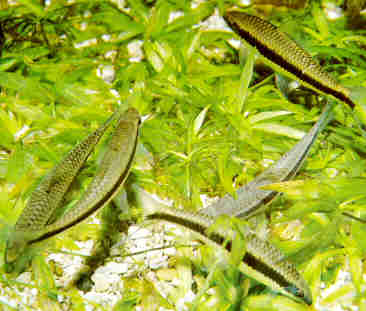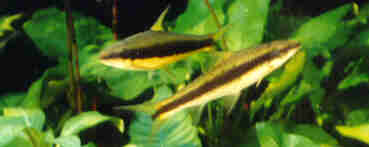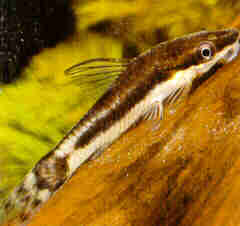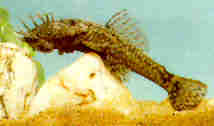
Photo from The Optimum Aquarium

Last update: June 29, 1999
After you go to all the trouble of setting up and aquascaping a nice planted tank, it's foolish to not add fish that are not algae compatible, if you catch my drift. If you didn't catch it, I mean it's a Good Thing to add algae eaters. And more importantly, it's a Very Good Thing to add a variety of algae eaters. If you take the time to inspect algae eaters in a store, you will notice that there are different styles of mouths: nibbling, scraping, sucking, rasping, tugging, ripping, etc. One might even think that these different styles of mouths have evolved to eat different types of algae! Think about that. Here are a few of our favorite algae eaters.
 |
Ah, yes, the difficult-to-find yet not-to-be-without Siamese
Algae Eater (SAE), Crossocheilus siamensis. You may find it in stores
as a "Siamese Flying Fox". Take careful note of it's side stripe
- black with jagged edges. The more common regular Flying Fox has a sharp
edged black stripe with a distinct bronze band above it. Avoid regular
Flying Foxes - they are attractive but worthless.
Photo from The Optimum Aquarium |
 |
The SAE is the only thing positively known to eat the dreaded Black Beard Algae (really a type of red algae). These little guys will keep your tank free of this nuisance. |
 |
Another super algae eater is the Farlowella acus. These
are the smaller of the forms found in fish shops. The larger (and more
expensive) form is the Royal Farlowella. These guys get pretty darn
big. F. acus stays small enough to look right at home in a plant
tank. I suspect the bigger Royal might even get an appetite for real
plants.
Farlowella acus is especially effective on soft green algae types. . |
 |
Otocinclus sp. are easy to find and darn good algae eaters.
Get a bunch - a dozen work well in a 50 gallon tank.
Photo from The Optimum Aquarium |
 |
The Blue Antenna Catfish, Ancistrus dolichopterus, is a great
algae eater but hard to find. Males have real cool fleshy "antennas"
on their heads.
Photo from The Optimum Aquarium |
 |
Another type of Ancistrus with spots, white tail markings and less cool antenna. |